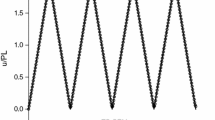Abstract
Higher-order Time Domain Finite Element Method (TDFEM) based on the nodal interpolation is proposed for two-dimensional electromagnetic analysis. The detailed algorithms of the method are presented firstly, and then the accuracy, CPU time and memory consumption of the higher-order node-based TDFEM are investigated. The high performance of the presented approach is validated by numerical results of the transient responses of Transverse Electric (TE) field and Transverse Magnetic (TM) field in a rectangular waveguide.
Similar content being viewed by others
References
A. Bertolani, A. Cucinotta, S. Selleri, et al. Overview on finite-element time-domain approaches for optical propagation analysis. Optical and Quantum Electronics, 35(2003)15, 1005–1023.
Sebastien Pernet, Xavier Ferrieres, and Gary Cohen. High spatial order finite element method to solve Maxwell’s equations in time domain. IEEE Transactions on Antennas and Propagation, 53(2005)9, 2889–2899.
D. Jiao and J. M. Jin. Three-dimensional orthogonal vector basis functions for time-domain finite element solution of vector wave equations. IEEE Transactions on Antennas and Propagation, 51(2003)1, 59–66.
Rickard L. E. Petersson and Jin Jian-Ming. A two-dimensional time-domain finite element formulation for periodic structures. IEEE Transactions on Antennas and Propagation, 53(2005)4, 1480–1488.
Shao Zhenhai and Hong Wei. Generalized Z-domain absorbing boundary conditions for time-domain finite-element method. Antennas and Propagation Society International Symposium, IEEE, Fukuoka, Japan, 2000, Vol.2, 765–768.
Jiao Dan and Jin Jian-Ming. A general approach for the stability analysis of the time-domain finite-element method for electromagnetic simulations. IEEE Transactions on Antennas and Propagation, 50(2002)11, 1624–1632.
Ali E. Yılmaz, Lou Zheng, and Jin Jian-Ming. A single-boundary implicit and FFT-accelerated time-domain finite element-boundary integral solver. IEEE Transactions on Antennas and Propagation, 55(2007)5, 1382–1397.
Eric Douglas Branch. A higher-order finite element method for computing the radar cross section of bodies of revolution. [Doctorial Dissertation]. University of Illinois, 2001.
P. Silvester. A general high-order finite-element analysis program. IEEE Transactions on Microwave Theory and Technology, 17(1969)4, 204–210.
Roberto D. Graglia, Donald R. Wilton, and Andrew F. Peterson. Higher-order interpolatory vector bases for computational electromagnetics. IEEE Transactions on Antennas and Propagation, 45(1997)3, 329–342.
Roberto D. Graglia and Guido Lombardi. Singular higher-order complete vector bases for finite methods. IEEE Transactions on Antennas and Propagation, 52(2004)7, 1672–1685.
Milan M. Ilić and Branislav M. Notaros. Higher-order hierarchical curved hexahedral vector finite elements for electromagnetic modeling. IEEE Transactions on Microwave Theory and Techniques, 51(2003)3, 1026–1033.
Zsolt Badics, Bogdan Ionescu, and Zoltan J. Cendes. High-order adaptive time-domain solution of nonlinear coupled electromagnetic-thermal problems. IEEE Transactions on Magnetics, 40(2004)2, 1274–1277.
Liu Jian. Higher-order finite element-boundary integral method for electromagnetic scattering and radiation analysis. [Doctorial Dissertation]. University of Illinois, 2002.
Jianming Jin. The Finite Element Method in Electromagnetics. New York, Wiley, 1993.
Author information
Authors and Affiliations
Corresponding author
Additional information
Supported by National Natural Science Foundation of China (No. 60601024).
Communication author: He Xiaoxiang, born in 1976, male, Ph.D., Associate Professor.
About this article
Cite this article
He, X., Tang, W. Higher-order node-based TDFEM for transient electromagnetic analysis in rectangular waveguide. J. Electron.(China) 26, 537–542 (2009). https://doi.org/10.1007/s11767-008-0006-y
Received:
Revised:
Published:
Issue Date:
DOI: https://doi.org/10.1007/s11767-008-0006-y




